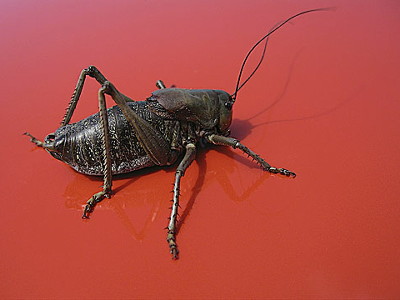7 species of cannibalistic creatures for the survival of the species

' Cannibalism ' is an ethically unacceptable act in the human world, but it is not uncommon in the animal world and has been confirmed among more than 1500 species of animals. Among them, here are 7 types of creatures known for cannibalism.
7 animals that eat their own kind --The Week
Copidosoma floridanum
http://facstaff.cbu.edu/~seisen/CopidosomaFloridanum.htm
◆ 1: Smalltooth sand tiger
The most 'brutal' example of cannibalistic animals is the smalltooth sand tiger. In this smalltooth sand tiger, a large fetus eats another weak fetus while in the womb. Scientists think it's a strategy for two shark babies, which are usually born, to grow so large that they aren't targeted by other predators when they are born by their mothers. In the smalltooth sand tiger, one female mates with multiple males, so there are multiple half-brothers in the womb, but a strong fetus with the same father joins forces to make other small half-brothers. Recent studies have suggested that they seem to be growing as food.

By
◆ 2: Polar bear
Polar bear cannibalism does not occur frequently, but sometimes it eats its own children. For example, in 2011, wildlife photographer Jenny Ross took a snapshot of an adult bear eating a corpse of a small bear. Climatologists say that climate change has melted Arctic ice and reduced the chances of catching their favorite seals, but in 2008 Germany

By
◆ 3: Spider
Various types of black widow, from black widow spiders to giant poisonous spiders, eat smaller male spiders after sexual intercourse. LiveScience says, 'The cannibalism of spiders may have been caused by various evolutionary processes, such as research on species conservation and sexual selection mechanisms,' but simply postpartum hungry female spiders. It seems that it is thought that it is because there is a male spider that is the best size for eating right in front of you.

By
◆ 4: Hamster
Hamsters are adorable and cute animals, but it is not uncommon for mother hamsters to eat their own newborn children. According to a site that describes a hamster's upbringing course, they eat and nourish their children so that they don't run out of milk nutrients while they're milking and kill each other. It may be. To avoid this, feed your mother hamster well and avoid touching newborn hamsters with your bare hands.

By oopsilon
◆ 5: Copidosoma florata
Copidosoma florida, a type of parasitoid wasp, pierces a caterpillar with a needle to paralyze it, and injects one fertilized egg born by a female and one unfertilized egg born by a male into the body of the caterpillar. To do. As many as 2000 larvae are born in the body of a living hornworm, of which about 50 females are born with no reproductive organs and large jaws and eat male larvae as much as possible. I will roll it up. This is believed to be the wisdom of leaving only the few males needed for reproduction.

◆ 6: Chicken
Female chickens eat their laid eggs because the shells of their eggs become thin if they do not get enough calcium. Farmers prevent this by placing golf balls and the like as fake eggs to prevent chickens from eating eggs.

By
◆ 7: Trough salamander
Mole salamander larvae take two different forms. The smaller one preys on aquatic invertebrates and the other eats the smaller salamander. Scientists point out that this often happens in areas with high numbers of trough salamanders.

Related Posts:
in Creature, Posted by logu_ii







